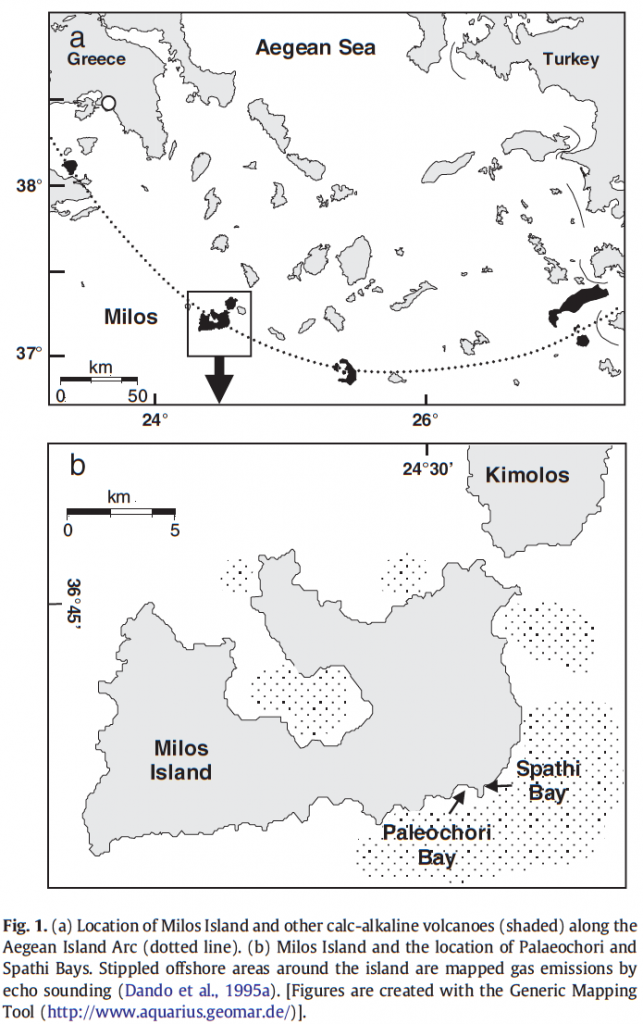Arsenic (As) is naturally enriched in most terrestrial and marine hydrothermal systems. Its discharge from shallow-sea hydrothermal vents into coastal marine environments can dramatically affect the surrounding ecosystems. Shallow-sea hydrothermal venting of acidic (pH~5), hot (40–116 °C), and highly sulfidic (up to 3.1 mM H2S) fluids occurs at Palaeochori and Spathi Bays, off the southeast coast of Milos Island, Greece. Two distinct types of fluids, both extremely As enriched, were collected from the submarine vents often within a few meters of each other: (1) a high-Cl  fluid (enriched in Cl by up to 47% relative to seawater) depleted in Mg and SO4 and enriched in major (Na, Ca, K, B, Sr, and Br) and minor/trace elements (Si, Li, Rb, Ce, As, Fe, Mn, and Ba), and (2) a low-Cl fluid (depleted in Cl by up to 66% relative to seawater) also depleted in Na, Mg, SO4, and Br. The maximum concentration of As reached 39 μM in the high-Cl fluids and up to 78 μM in the low-Cl fluids. This is approximately 3000 times the concentration of As in seawater and far exceeds the concentrations typically found in mid-ocean ridge (MOR) and back-arc basin (BAB) fluids, which are typically b0.7 and b10 μM, respectively.
fluid (enriched in Cl by up to 47% relative to seawater) depleted in Mg and SO4 and enriched in major (Na, Ca, K, B, Sr, and Br) and minor/trace elements (Si, Li, Rb, Ce, As, Fe, Mn, and Ba), and (2) a low-Cl fluid (depleted in Cl by up to 66% relative to seawater) also depleted in Na, Mg, SO4, and Br. The maximum concentration of As reached 39 μM in the high-Cl fluids and up to 78 μM in the low-Cl fluids. This is approximately 3000 times the concentration of As in seawater and far exceeds the concentrations typically found in mid-ocean ridge (MOR) and back-arc basin (BAB) fluids, which are typically b0.7 and b10 μM, respectively.
We used a combination of elemental analyses and stable and radiogenic isotope data (oxygen, deuterium, and strontium) to understand the primary controls on As enrichment. Those parameters all indicated that the fluids were a mixture of seawater and a hydrothermal fluid originally derived from seawater but altered by water–rock interaction, subcritical phase separation (boiling), and vapor/brine segregation. Since As was extremely enriched in both the high-Cl and the low-Cl thermal fluids, we conclude that this element readily partitions into the
vapor phase in the Milos hydrothermal system. The original source of As is most likely the leaching of the greenschist facies metamorphic basement rocks transpierced by an abundance of secondary quartz and calcite veins rich in pyrite. It is possible that these veins were deposited from As-rich magmatic fluids, similar to some epithermal Au deposits. A poorly-crystalline orpiment precipitates as hydrothermal fluids mix with overlying seawater, and removes much of the dissolved As prior to discharge.
